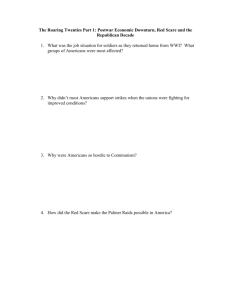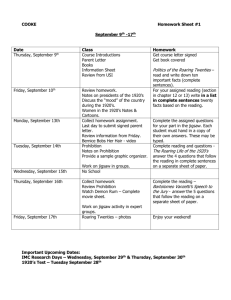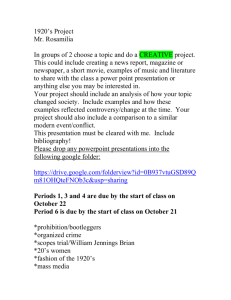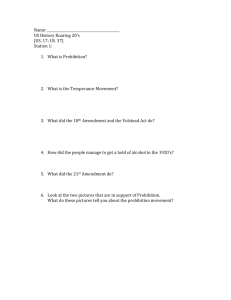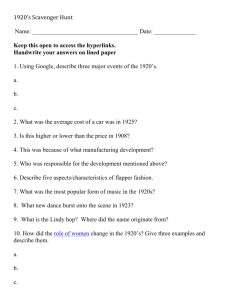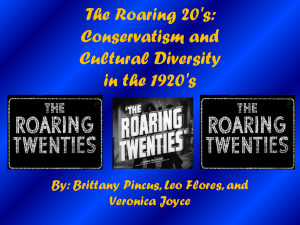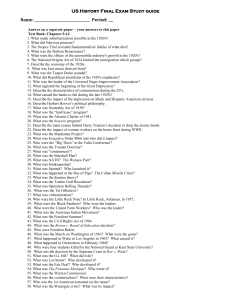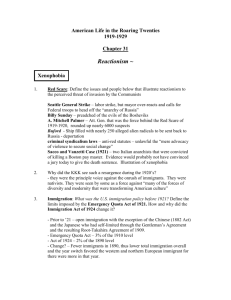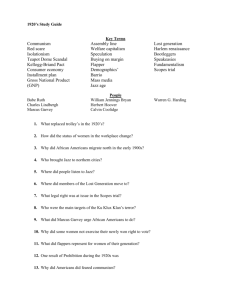Roaring 20s Outline study Guide
advertisement
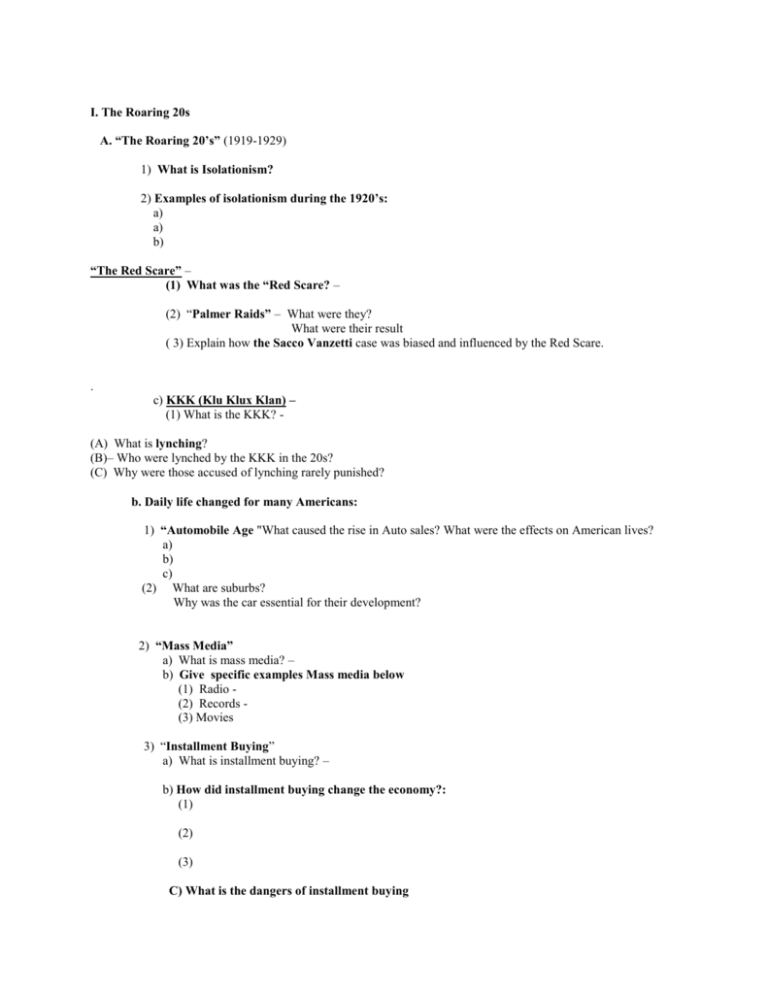
I. The Roaring 20s A. “The Roaring 20’s” (1919-1929) 1) What is Isolationism? 2) Examples of isolationism during the 1920’s: a) a) b) “The Red Scare” – (1) What was the “Red Scare? – (2) “Palmer Raids” – What were they? What were their result ( 3) Explain how the Sacco Vanzetti case was biased and influenced by the Red Scare. . c) KKK (Klu Klux Klan) – (1) What is the KKK? (A) What is lynching? (B)– Who were lynched by the KKK in the 20s? (C) Why were those accused of lynching rarely punished? b. Daily life changed for many Americans: 1) “Automobile Age "What caused the rise in Auto sales? What were the effects on American lives? a) b) c) (2) What are suburbs? Why was the car essential for their development? 2) “Mass Media” a) What is mass media? – b) Give specific examples Mass media below (1) Radio (2) Records (3) Movies 3) “Installment Buying” a) What is installment buying? – b) How did installment buying change the economy?: (1) (2) (3) C) What is the dangers of installment buying 4) Prohibition started. – What was prohibition. What Amendment created this and in which year?, a) Famous Terms and People from Prohibition: Identify the below: (1) “bootlegging” (2) Carrie Nation – (3) Al Capone B) Prohibition ended with the passage of what amendment to the Constitution? When was it ratified? (1) Why did Prohibition fail?: (a) (b) c. The U.S. Economy changed in the 1920’s 1) How did the U.S. economy change in the 1920’s?: a) The U.S. became the richest nation in the world. (1) What is Gross National Product (GNP? (2)Describe the rate in the increase to the U.S. gross national product (GNP) during the 20s. . b) Labor Unions encouraged workers to strike in the 1920’s: (1) Unions are formed by workers to get better pay and working conditions; the first unions were formed by workers in the 1800’s (2) Identify Problems Unions faced in the 20s (3) Why did Many of the strikes fail? 2) People made a lot of money buying and selling stock in the Stock Market: a) As the economy expanded, what happened to the value of American companies? b) Why were so many Americans able to purchase stock? c) What is meant on margin? d. Politics in the 1920’s 1) Two Presidents in “The Roaring 20’s”: a) Warren Harding (Republican) (1921-1923) President at the beginning of the “Roaring 20’s”; Harding died in office in 1923. (1) Harding appointed his friends to offices in his government. (2) What was the “Teapot Dome” Scandal (1922) (3) How is the Harding administration viewed today regarding corruption? b) Calvin Coolidge (Republican) (1923-1929) President at the end of the “Roaring 20’s”. (1) Describe Coolidge economic policy that are reminiscent of the Gilded Age (a) (b) Instructions: By the end of the unit you should easily answer these questions!!! Main Ideas: Use your above notes to answer these question. 1. After World War I, President Harding stated that many Americans wanted to return to “normalcy”. What did he mean by this statement? 2. After World War I, the U.S. followed a policy of “isolationism” in its affairs with other nations. What is “isolationism”? Does the U.S. follow this policy today? 3. How Americans lived changed in the 1920’s. Give 4 examples to support this statement. 4. The “Automobile Age” began in the 1920’s. Which car started the Automobile Age? Who invented this car? 5. Give 2 examples of how the car changed America. 6. What is “mass media”? List 3 examples of mass media from the 1920’s. 7. Why are the 1920’s sometimes called “The Jazz Age”? 8. Which event from World War I caused “The Red Scare” to occur in the U.S. in the 1920’s? 9. What were “Palmer Raids”? Why do you think some Americans believed that the Palmer Raids were against the law? 10. What was Prohibition? Why did Prohibition fail? 11. Read the definition for “trade union”. Based on the definition, why do workers form trade unions? Do you think the “Red Scare” helped or hurt unions in the 1920’s? Explain your answer. 12. How did “installment buying” change the U.S. economy during the 1920’s? How did installment buying change the U.S. gross national product during the 1920’s? 13. How did installment buying effect the Stock Market in the 1920’s? 14. List the 2 Presidents from “The Roaring 20’s”. 15. What was the “Teapot Dome” scandal? Who was President when this event occurred? 16. Describe Calvin Coolidge’s economic policies during his time a President. 17. Who was John Scopes? Why was he arrested in Tennessee in the 1920’s? 718 What was the political and social ramifications that still continue to this day? Dictionary Practice : Identify the term give its definition using a dictionary and in the correct context of what is being studied. normalcy isolationism socialism communism free enterprise capitalism anarchism immigrants nativism lynching urban rural suburbs Prohibition bootlegging trade union strike gross national product stock stock exchange dividend on margin isolationism evolution laissez-faire tariff import export creationism Harlem Renaissance People: Explain why each of the following people were important during “The Roaring 20’s”. Use your answers to the Main Idea questions to help you. John Scopes Charles Darwin Calvin Coolidge Warren Harding “Sacco and Vanzetti” A. Mitchell Palmer Al Jolson Louis Armstrong Klu Klux Klan Henry Ford Woodrow Wilson
